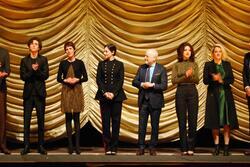Taking an L? Maybe, maybe not.
First aired on Showtime in 2004, The L Word became the first ever TV series that documented the lives of an ensemble of queer women. Modeled after the life of creator, screenwriter, and director, Ilene Chaiken, The L Word includes a groundbreaking set of TV firsts: television’s first deaf lesbian, its first regularly occurring transgender character, and its first interracial lesbian couple. The L Word pushed social boundaries and explored taboo themes such as: bisexuality, gender nonconformity, same-sex parenting, addiction, and rape. Over the almost 14 years since the show was first aired, The L Word has received much praise for its intimate storylines, representative depiction of the lesbian community, smart humor, and affinity for drama. However, because a monolithic gay experience or gay culture does not exist, The L Word didn’t (and perhaps couldn’t) capture the full picture of what it means to be a lesbian.
Over the five years that The L Word was on television, the show became increasingly more inclusive, but the original cast was a group of eight women: four white lesbians (Tina, Marina, Dana, Shane), one biracial lesbian (Bette), one white bisexual woman (Alice), one white woman who questioned her sexuality (Jenny), and one middle-aged straight black woman (Bette’s half-sister, Kit). With a majority white, early 30s, upper-middle class cast, The L Word was criticized for not representing the multitude of demographics included within the lesbian community. As the show progressed, viewers met two Latina lesbians, one black lesbian soldier, a transgender man, and a deaf lesbian, but the show still struggled to take a truly intersectional approach to its subject matter, and sometimes even promoted degrading stereotypes.
From my perspective as a Jewish woman, I couldn’t help but notice the show’s shortcomings in terms of Jewish representation. Although a Jewish woman herself, Ilene Chaiken’s portrayal of Jewish culture and identity was limited. However, because the one Jewish character, Jenny Schecter, is based on Chaiken herself, perhaps this is the main reason why the show presents a very narrow portrayal of Jewishness. Similarly to there being no monolithic gay experience, there’s no monolithic Jewish experience, which makes it rather difficult to represent all forms of Judaism in a single character.
Jenny Schecter’s character was called “The L Word character you love to hate,” and I find this to be quite true. Jenny is brutally annoying, and her characteristics seem to be entirely based on the definition of the Jewish American Princess stereotype. But it gets worse. In scenes where she wears a chai necklace, the chai is backwards, reading from left to right instead of the Hebrew right to left–a small mistake but one noticeable to the Jewish eye. In some scenes Jenny sings what the closed captions call a “Hebrew melody,” but it’s actually just her repeating the beginning to many Jewish prayers: Baruch atah Adonai eloheinu melech ha'olam asher kidshanu bimitzvotav. Again, to the non-Jewish eye, not a big deal, but to Jews it goes to show that there’s definitely a lack of understanding, and effort, when it comes to how Jews are portrayed in the media.
In seasons two and three, Jenny begins to truly come to terms with not being straight, and her coming-out coincides with flashbacks and dreams of childhood sexual abuse. As she copes with her trauma, she starts a project in which she learns about her family’s Jewish roots, and Holocaust past. There’s a touching scene in which Jenny records herself asking her mother questions about her family’s history, but ultimately the scene portrays the Holocaust as the core facet of Jewish identity. While this may be true for some Jews, having a Jewish character on a mainstream TV show, whose Jewish heritage stems directly from the Holocaust, essentially erases the dynamic and multi-faceted nature of the Jewish people as a whole.
Even with all of its faults, The L Word was a radical shift in television and pop culture. By simply putting women in front of the camera and behind it, The L Word was revolutionary. But The L Word does more than just that. It provides a safe haven in the big world of mass media for lesbians who previously didn’t see themselves adequately represented in straight, cisgender, male-produced television. It acknowledges the fluidity of sexuality and reminds us that it’s okay to not know what we’re feeling all the time. In my experience, I’ve seen it function as an educational resource for newly out lesbians–a dramatic and sexy resource, but educational nonetheless. Perhaps most importantly, it teaches all of us that while it may be impossible for any one show to fully represent any group of people, representation matters, and we must continue to work to do it better.
This piece was written as part of JWA’s Rising Voices Fellowship.







